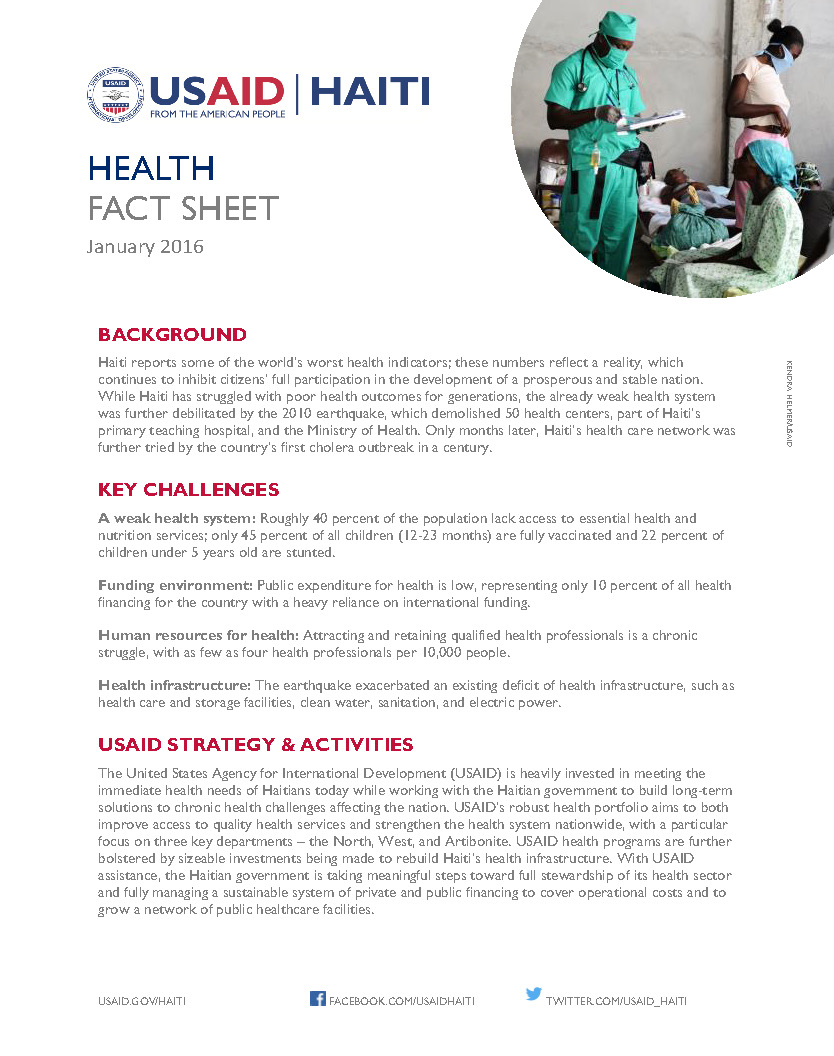Background
Haiti reports some of the world’s worst health indicators; these numbers reflect a reality, which continues to inhibit citizens’ full participation in the development of a prosperous and stable nation. While Haiti has struggled with poor health outcomes for generations, the already weak health system was further debilitated by the 2010 earthquake, which demolished 50 health centers, part of Haiti’s primary teaching hospital, and the Ministry of Health. Only months later, Haiti’s health care network was further tried by the country’s first cholera outbreak in a century.
Key Challenges
A weak health system: Roughly 40 percent of the population lack access to essential health and nutrition services; only 45 percent of all children (12-23 months) are fully vaccinated and 22 percent of children under 5 years old are stunted.
Funding environment: Public expenditure for health is low, representing only 10 percent of all health financing for the country with a heavy reliance on international funding.
Human resources for health: Attracting and retaining qualified health professionals is a chronic struggle, with as few as four health professionals per 10,000 people.
Health infrastructure: The earthquake exacerbated an existing deficit of health infrastructure, such as health care and storage facilities, clean water, sanitation, and electric power.
USAID Strategy & Activities
The United States Agency for International Development (USAID) is heavily invested in meeting the immediate health needs of Haitians today while working with the Haitian government to build long-term solutions to chronic health challenges affecting the nation. USAID’s robust health portfolio aims to both improve access to quality health services and strengthen the health system nationwide, with a particular focus on three key departments – the North, West, and Artibonite. USAID health programs are further bolstered by sizeable investments being made to rebuild Haiti’s health infrastructure. With USAID assistance, the Haitian government is taking meaningful steps toward full stewardship of its health sector and fully managing a sustainable system of private and public financing to cover operational costs and to grow a network of public healthcare facilities.
Health services delivery: USAID support is increasing access to essential primary health, nutrition and family planning, HIV/AIDS, and tuberculosis services to underserved communities. Currently, USAID supports 164 health facilities that provide access to primary health care services for nearly half of the population.
Health systems strengthening: To ensure sustainability of these investments, efforts are underway to build needed leadership, managerial and administrative skills within the Ministry of Health. These leaderships and management skills will improve oversight and allow the GOH to manage healthcare assets more transparently and effectively.
Improving services and focused support for persons with disabilities: USAID health activities increase access to quality services for persons with disabilities by establishing systems and programs within key Health Ministry units and NGOs to ensure that government and civil society have the capacity to provide care, rehabilitation and support for their reintegration into society.
Rebuilding public health infrastructure: Working alongside other international donors, USAID is helping to rebuild Haiti’s primary public tertiary and teaching hospital (the General University Hospital), to construct a new maternity ward at St. Justinien Hospital in Cap Haitien, and to reconstruct the National Campus of Health Sciences. Additionally, USAID is renovating 12 smaller health care centers and schools, improving infrastructure and accessibility for people with disabilities.
Key Accomplishments
Contributing to improved healthcare services:
- In 2012, nearly all children (92 percent) less than a year old treated at USG-supported programs were fully vaccinated, compared to an average of 60 percent nationally.
- The proportion of underweight children under 5 years old has declined by half over the past six years, down from 22 percent to 11 percent.
- Voluntary use of modern contraceptives has increased from 25 percent to nearly 35 percent.
- The number of HIV+ patients on treatment has increased from 60 percent to 82 percent.
- Early infant diagnosis of HIV increased from 50 percent to more than 75 percent (2012 – 2014).
Strengthening the health system: USAID initiated a Public Financing Management reform with the Ministry of Health in order to begin government-to-government financing in the health sector. With assistance from USAID, the Ministry has published three annual National Health Account reports, which provide evidence to monitor trends in health spending for all sectors – both public and private – to improve planning and allocation of resources for future years and increase overall accountability.
Care and support for persons with disabilities: After the earthquake, Haiti had no local rehabilitation specialists. By 2014, USAID programs trained 72 specialists in rehabilitation, orthotics, and prosthesis.
Improved access to schools for students with disabilities: USAID retrofitted six schools are now upgraded to be handicapped accessible in southeast and central Haiti.
Expanding the health workforce: USAID supported the training of 11,000 community health workers who serve rural communities without access to nearby health services.








Comment
Make a general inquiry or suggest an improvement.